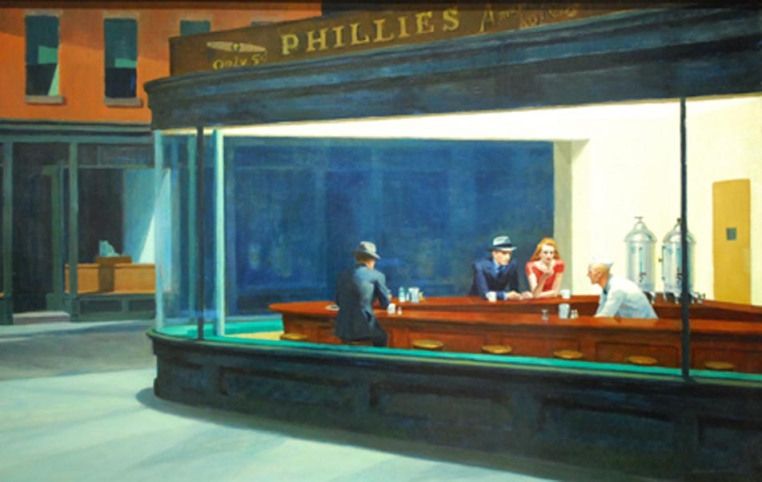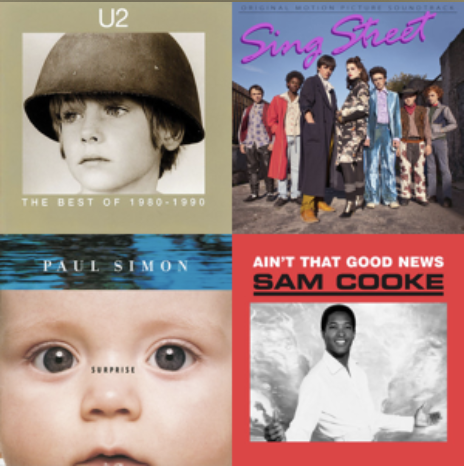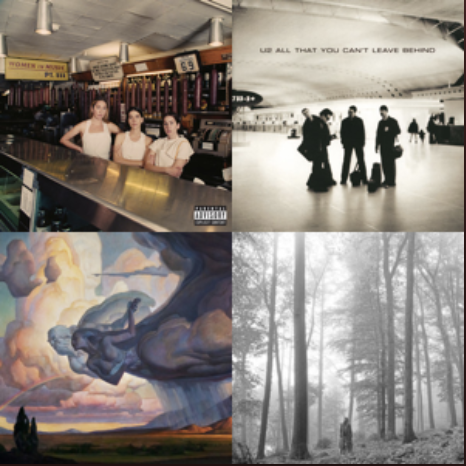Editor’s Note: This is an edited version of a paper that was originally presented as part of Calvin College’s Festival of Faith and Music. This biennial conference brings together musicians, critics, journalists, artists, and listeners to discuss and celebrate popular music—hoping to bridge the gap between the church and popular art. The Curator is delighted to share thoughtful music criticism from the 2015 Festival. Over the coming months, The Curator will publish one paper a week in order to continue and extend the conversation from the Festival. On a range of artists and songs, each paper engages and interprets popular music from a faith perspective.
Julie Hamilton’s piece is well-paired with Joe Kickasola’s piece published last week.
“Boney’s high on china white, Shorty found a punk,
Don’t you know there ain’t no devil, there’s just God when he’s drunk,
Well this stuff will probably kill you,
Let’s do another line, what you say we meet down on Heartattack and Vine.” —”Heartattack and Vine”
Tom Waits, a preacher of the “dysangelion” (bad news), rhapsodizes the depravity of the world as normative, showing us not to take for granted the surprise of something not going wrong. As a beatnik, Waits’s lyrics testify to a life from skid row in form of a brawling psalter. His musical genres evolve alongside his own vagabond drifting from nightclub jazz and growling blues in vaudeville theatres and seedy dive bars, continually innovating and reinventing harmony and rhythm. From early barfly tales of heartbreak to his guttural nightmares of apocalyptic doom, Waits uses transgression and disruption to unmask societal hierarchies and pretentious bourgeoisie charades.
If Kerouac’s On the Road could narrate the biography of one American musician, it would be Tom Waits. As Kerouac’s biographer Ann Charters writes, the Beat genre that defined a cultural era meant more than “a state of exalted exhaustion”, it also referenced the ‘Beatific Vision’ which Catholics describe as the celestial vision of God by the saints and the blessed.[1] Both terms could arguably characterize the persona and the music of Waits—the itinerant, vagabond drifter, stumbling down seedy alleys to the back door of heaven.
Born in the back of a taxicab in 1949, Tom began early as a nomadic traveler, leaving high school at fifteen. Living between his car and the Live Tropicana Motel in Santa Monica (with the likes of Jim Morrison and Janis Joplin), his early albums Closing Time (1973) and Heart of a Saturday Night (1974) portray a lonely barfly, drowning his sorrows in whiskey, while chain-smoking a pack of unfiltered cigarettes. His drunken cabaret combines blues with jazz in wistful and tender melodies narrating his meandering jaunt from gig to gig. Often occupying nightclub stage corners as the evening storytelling bard with his piano and jazz set, in his early music, Waits is a troubadour of hangovers and one-night stands. His alcoholic ode to loneliness is perhaps best captured in his nod to American painter Edward Hopper in the title of his live third album Nighthawks at the Diner (1977), the namesake of Hopper’s seminal work from 1942. Hopper’s iconic portrait of noir Americana captures loneliness and desolation within the urban landscape that parallels Waits musically in his early career.

Throughout Weaits’ discography, his proletariat characters evolve, but so does his musical innovation as he turns common, household objects into rhythmically complex sounds. From folksy singer-songwriter melodies and lyrics, to his experimental junkyard orchestra of bagpipes and toilet seats, Waits’ rhythms and textures mature, creating an imaginative mood and tangible atmosphere, sculpting sound with unorthodox materials.
However, the entrance of Kathleen Brennan into his life affected Waits in a two-fold manner: not only did he marry her, but she also became the precursor to Waits’ significant aesthetic transformation, breaking with his producers and record label to reinvent his artistic persona. He credits her for not only saving his career from cliché and stagnation, but also from meeting the same fate of his many miserable drunken characters. Meeting onset in Francis Ford Coppella’s film One From the Heart and marrying shortly after, Brennan introduced Waits to experimental European avant-garde music and collaborated with him as a songwriter and producer, leading to his seminal musical trilogy: Swordfishtrombone (1983), Rain Dogs (1985), and Frank’s Wild Years (1987). The theatrical trilogy establishes Waits’ working class portraits that are enslaved to their circumstances, incorporating memoirs of the dark and damaged—lives that are smoked down to the filter before they are discarded. His methodological and thematic metamorphosis leads him to play with opposites, pairing gothic lyrics with familiar melodies (such as the waltz or nursery rhyme), creatively reconfiguring his deconstructed, global sounds into cemetery polkas and obituary mambos. Transitioning from Beatnik Americana to grotesque avant-garde, a recurring carnival motif structures Waits’ storytelling, both as a central theme and his form of narration.
Tom’s Carnivalesque: Bakhtin and the World of the Grotesque
The 20th century philosopher and literary theorist Mikhail Bakhtin helps consider the thematic significance of the carnival as a rhetorical and political hermeneutic through his complex analysis of polyphony and dialogical techniques–a mode of symbolic storytelling that employs perspectives from a variety of characters–utilized by Waits. In Rabelais and His World, Bakhtin argues the medieval marketplace and folk culture’s carnival are the ideal socio-political assembly for subverting normative hierarchical systems of power through means of anarchy.[2] The carnival was a seasonal festival where parodies of Christmas and Pascal laughter were allowed—namely, the Feast of Fools, where hyperbole and chaos sought to unmask societal mores by means of transgression and disruption (e.g. Mardi Gras).
Bakhtin explains: “During the carnival, there is a temporary suspension of all hierarchic distinctions and barriers among men and of certain norms and prohibitions of usual life”, the emperor becomes the “slave” or jester and vice versa.[3] The carnival functions to create freedom in society by violating the architecture of established normative politics through parody and caricature, opening the door to a fresh vision and new order of the world.[4] Here the odd, the freak, and the misfit have an egalitarian place in this temporary, utopian counter-society, hospitable to the outcasts and underdogs. This paradigmatically alters the normative standards of the healthy, wealthy, and beautiful. The carnival vision is unsettling and destabilizing in its reorienting perspective and eschatological vision for humanity.
Bakhtin’s world-upside-down ‘carnivalesque’ trope of inversion is drawn from classical satire, specifically Menippean satire and the Socratic dialogues. Menippean satire is the form of the ‘carnivalesque’ as a genre or world, allowing a unique perspective on reality through an inverted, fantastic, and unconventional viewpoint. Working with an organized chaos of moving viewpoints and different voices, mocking various ideologies, modern examples of Menippean satire include Swift’s Gulliver’s Travels, Carroll’s Alice in Wonderland and Voltaire’s Candide, Groucho Marx, and Monty Python. It often employs the grotesque as a trope of inversion and paradox in its’ allegorical narratives, where characters communally perform towards a utopic reality.

The ‘carnivalesque’ form within Menippean satire, utilizes Socratic dialogism, where the function of the speaker and listener change places. Differing from monologism’s single voice, Socratic dialogism is truth born between two or more voices collectively searching for it.[5] This occurs between Waits’ many characters collectively, and between Waits’ characters and his audience. Bakhtin helps us to understand the polyphony of Waits’ characters as distinct voices from Waits the songwriter. Utilizing polyphony as his rhetorical trope of “many voices,” Waits ensures distance between the tarnished portraits he creates and his own autobiographical realism (save perhaps the drunken piano player from his early career). Rather, his anarchical claptrap of characters exist within his crafted world of the ‘carnivalesque,’ a world more concerned with the narrative and rhythmic authenticity of his character’s stories and his ability to incarnate these stories through performances. Waits has noted that the process of starring in nearly thirty film roles has allowed him the freedom to embody fictional characters without them being mimetic of his own life. Thus, Waits as both writer and performer, reveals and conceals himself within and through his polyphonic lyrics.
In his theatrical play-turned-album The Black Rider (1993), Waits collaborated with William S. Burroughs in the 19th century German-Expressionist influenced Faustus legend, where a file clerk makes a pact with the devil, cloaked in the guise of a parasitic carnival ringmaster: “Lay down in the web of the black spider/I’ll drink your blood like wine.” Funnel cake pageantries and cotton candy confections have no place in the dark imagination of the German play, but rather the grotesque carnival, with its “chamber of horrors” and “morbid curiosity” subverting moral standards through the world of a circus.[6] Waits heightens the effect of the circus by playing the steam engine run calliope, in all its farcical and noisy, yet whimsical atmosphere. The circus barker in the opening track “Lucky Day (Overture)” roars into a megaphone announcing “Harry’s Harbor Bizarre for Human Oddities,” including the Three Headed Baby, Hitler’s brain, the German midget, the monkey woman, the dog face boy, and the mule-faced woman. We are given a strange cast of clowns, people that are rejects in a world of privilege, education, and pedigree. They are spectacles, selling their skills as malformed monsters to willing gawkers. There is a place for every voice in the polyphony of the ‘carnivalesque’ – a counter-community, a society of outcasts, a family of freaks. Waits shows us the irony, or rather disparity between the place of amusements— Midway Ferris wheels, balloon-popping, prize-winning, corndog frenzy— is actually a mask hiding the suffering of the overlooked and disposed.
Bakhtin considers the employment of the medieval carnival’s grotesque realism in order to conflate and unsettle bourgeoisie standards of decorum, chivalry and symmetry, especially in their equivocation with piety and godliness. Folk culture championed folly, subverting and lowering lofty, spiritual and abstract dynamics to the body, in all its’ humanity and physicality. We might be reminded of the bawdy and the crude characterization of the Miller from Chaucer’s Canterbury Tales, with “his mouth like a furnace door/ He was a jester and could poetize, / But mostly all of sin and ribaldries.”[7]
Bakhtin contends that the grotesque offers us paradoxical imagery, utilizing a kind of exaggerated, disproportionate symbolism to illustrate humanity’s incompleteness, subject to transformation. Likewise, Waits employs hyperbole as a critical descriptive trope, aggrandizing details for illustrative purposes, depicting an expansive landscape in which his characters inhabit. The short story author and novelist Flannery O’Connor, whose writing genre was paradigmatic of the grotesque, understood the intrinsic need for embellishment, admitting that one has to scream at deaf people: “I use the grotesque the way I do because people are deaf and dumb and need help to see and hear.”[8] We might say that Waits is attempting something similar in both his mythmaking lyrics and visceral rhythms.
Grotesque as sermon of the ‘Dysangelion’
The grotesque portrays the spiritualized and contradictory, ranging in Waits’ music from gypsy folk caravans to demonic nightmares, in the voices of his circus ringmasters, outlaws, chain gang hollerins’, apocalyptic prophets, and unjust Pharisaical magistrates. His handicapped, freakish humans (e.g. “Tabletop Joe”, “Eyeball Kid”, “Scar-faced Ron”, the Camel Girl) are token “grotesque” caricatures, seasoning his surrealist storytelling. Taking on the role of the joker or jester from the carnival, Waits employs the grotesque thematically as a dialogical rhetorical technique to invert our perception of the world and its scumbag humdrum creatures. We might call him the preacher of the dysangelion, or the “bad news”, a prophet of doom, which should signal our connection to Menippean satire, since the very concept of preaching a Gospel seems counterintuitive to be “bad news.” For Waits, however, the grotesque is a normative attribute, if not liturgical formation, of the carnival.

The grotesque reaches toxic levels in his 1992 album Bone Machine, a Kafkaesque surrealist nightmare. A seminal record of bone-shaking rhythms, demonic cackles and bellowing roar portrays characters that range from the end time preacher on the side corner, the desperado and the macabre. “The Earth Died Screaming” employs absurd and incredulous wonders for apocalyptic dimensions of eschatology. Waits’ allusion to the biblical plagues of Exodus (“it rained mackerel, it rained trout”) imply the connection between the Scripture’s narrative scope of the fantastic, and the mythological aspects of the condemned being swallowed by Tartarus.
Blood Money (2002) is the music accompanying the tragic play of Woyzeck, a perverse true tale of jealousy-enraged murder told in stomp-and-growl marches, interspersed by soothing carnivalesque lullabies, such as “Coney Island Baby.” “God’s Away on Business” was aptly included on the soundtrack to Enron: The Smartest Men in the Room, where Waits’ lacerated vocal cords bark about the injustice of bureaucratic exploitation and oppression of “the poor, the lame, the blind.” His misanthropic fatalism sees the world going to hell in a handbasket from the authorities and corrosive powers left in charge— “killers, thieves, and lawyers,” to be precise. In a miasma of Hobbesian self-preservation, Waits concludes that this systemic damage is too great: God must be away on business because the atrocities are too deafening for God to remain silent. Who will save those that cannot help themselves from the exploitation of the powerful?
“Misery’s the River of the World” is a metronomic chant of humanity’s enslavement to perversity and self-interest, and the devil’s half-step behind God in cunning masquerades: “if there’s one thing you can say about mankind, /there’s nothing kind about man/…God builds the church, the devil builds a chapel/…the devil knows the world like the back of his hand.” Waits’ laryngitis croaks as he preaches on human culpability—we all have blood on our hands. “Starving in the Belly of a Whale” is nihilistic resignation to the tune of Halloween horror: “Life’s a mistake all day long. /Tell me, who gives a good goddamn, /you never get out alive/…If you live in hope you are dancing to a terrible tune.” This Jonah-themed descent into the inferno of humanity’s hellish realities, are a contemporary nod to Dante’s inscription above the gates of hell: “Abandon all hope you who enter here.” In what might be considered his darkest album, Tom’s descent into hell does not end with the macabre as his last word, as he employs a gospel of inversion to get our attention.
Nevertheless, how precisely is Waits’ grotesque actually the shock of grace? Since Waits has given us a normative where there is no docile God and no Deus ex machina to save his characters from the damage they inflicted on each other, the rare occurrences of grace appear as a disruption—a shock. Illogical in the enclosed system that Waits has provided for his audience, the presence of grace emerges de profundis (out of the depths)— as a trope of the carnivalesque. Theologian Ben Myer has suggested that grace itself is part of the grotesque in Tom Waits’s dysangelion:
“One of Waits’ most astonishing theological pronouncements, for example, is the gleeful hiss: Don’t you know there ain’t no devil, that’s just God when he’s drunk.’ Or on another occasion he wonders: ‘Did the devil make the world while God was sleeping?’ In such songs, God burst onto the stage not as the benevolent projection of our wishes and desires, but as the one who overturns our expectations and shatters our projections of what ‘God’ should be.[9]
Grace, in Myers’ interpretation of Waits, is a perversion of the world’s depravity. Its extravagance is excessive in the context of impoverished and broken systems. This unnecessary and undeserved gift of reprieve from suffering is strangely offered to all who desire it, regardless of the crimes they have committed—heinous or minor. Waits engages the grotesque to distort our own expectations of a just God through his rhetorical trope of conversion.
Joker Turned Unlikely Saint: The ‘Holy Fool’ of Inversion
Beyond the jester, joker and clown in the ‘carnivalesque,’ there is the ‘Holy Fool.’ Drawing from Dostoevsky and Orthodox theology, Bakhtin considers this marginal holy figure who utilizes inversion and reversal in order to lead the community to conversion or salvation. The Holy Fool reconstructs our vision to see the saint concealed in rags. As a marginal prophet shouting from the sidelines, the Holy Fool acts in odd ways to get our attention, by inverting societal norms. Bakhtin scholar Harriet Murav states: “They are understood by the hagiographers to be practitioners of asceticism, yet their behavior, even to hagiographers, is anti-ascetic.”[10]Holy Fools are considered saints whose unholy and impious actions unveil deeper truths.

This trope of the Holy Fool allows the degenerate figures to transcend themselves, revealing “man to man” as Bakhtin relates. By affirming the divine image in the human, the Holy Fool seeks to convey and reestablish the divinity of the human in all their brokenness, lack of education and depravity. We are misled if we judge Tom Waits as a frequenter of strip clubs and trashy bars to advocate their objectification and consumption. Rather, Waits risks being scandalized by his association with these places, seeking to humanize its occupants, rather than exploit them. Like one of Georges Rouault’s clowns in a Fellini circus, he hopes to unmask our pious criticisms and holier-than-thou sense of self-righteousness by telling their stories (e.g. “Christmas Card from a Hooker in Minneapolis,” “Heartattack and Vine”). In this way, Waits is an exorcist of our own prejudice, showing the listeners back to ourselves in the dialogical engagement with his cabaret of characters. An unlikely saint, Waits illuminates a path of suffering to sainthood, attending to the beauty in the gutter over whitewashed sepulchers, disarming our securities by making us uncomfortable through the foreign and unfamiliar.
For Tom Waits, narrative strategies and rhetorical structures of dialogical polyphony are theology. Waits’ theatricality represents both God and the most unholy humans. By taking on folly, he represents the human that is furthest away from God, like the Holy Fool takes on homelessness and wandering like Jesus. As Murav notes:
“Polyphony is understood to be a Christ-like self-effacement. Bakhtin’s reading of Christ as a figure in whom dialogue and carnival are central are from two Russian traditions of venerating Christ as a human being and venerating holy fools who perform disgusting and frequently obscene acts as Christ-like.”[11]
We catch glimpses of this hope in a handful of Waits’ rare, but poignant tunes. Despite the hellish universe and despicable crimes that his characters have committed, Waits gives us “Down There By the Train” and “Come On Up to the House.” As his earlier lyrics depict the lowest common denominator for every human is death, this depiction of hope and radical grace transfigures Waits’s grotesque. Off his Orphans: Brawlers, Bawlers and Bastards (2006) collection, “Down There By The Train” describes a kind of universal redemption open to the likes of Cain, Judas Iscariot, John Wilkes Booth, and even the soldier that pierced Christ’s side—murderers of the most innocent victims. Giving the recipe for a maximally damaged life, Waits assures that salvation is spendthrift, available for even those unable to believe:
“There’s a place I know where the train goes slow/
where sinners can be washed in the blood of the lamb/
there’s a river by the trestle down by sinner’s grove/
down where the willow and the dogwood grow/
you can hear the whistle, you can hear the bell/
from the halls of heaven to the gates of hell/
and sinner there’s room for the forsaken if you’re there on time. / You’ll be washed of all your sins and all your crimes…
If you’ve lost all your hope and if you’ve lost all your faith.
I know you can be cared for and I know you can be safe.”
It is a hymn of profligate grace, for those crawling to the train track crossroads in life’s final moments.
Waits continues in “Come on Up to the House” from Mule Variations (1999). No fuller act of mercy or magnanimity can be shown than the hospitality of welcoming every sinner through the door, a homecoming to all the wandering nomads we find littering Waits’ music. Waits acts like the Prodigal father, receiving his sons and daughters with open arms in their long-awaited nostos. The pilgrims are invited to come down off their crosses, their suffering is over at long last, and the wood will be put to better use. Waits insists that Hobbes’s view of nature is worth leaving behind: “does life seem nasty, brutish and short?/…The world is not my home, I’m just a passin’ thru/ You gotta come up to the house.” As the Holy Fool, the maximal inversion and world-upside-down action possible is offering mercy and grace in place of judgment and condemnation. If Christ, the archetype of holy fools does this for prostitutes and thieves, who is beyond the fold of grace’s reach? Are we not called to do the same?
Jesus’ Love Never Failed Me Yet
In the 1970s, Gavin Bryers was shooting footage for a documentary on the homeless in the city of London. Providentially, he unintentionally captured a recording of a homeless man, feebly, yet hopefully singing a simple tune: “Jesus Blood Never Failed Me Yet.” After looping the tune to play over 74 long minutes, Bryers overlade the tramp’s humble hymn with a gradual accompaniment of strings, culminating in a full orchestra. Tom Waits happened to hear this song playing on the radio one night on Kathleen’s birthday, and it became one of his favorite tapes. In 1993, Bryers asked if Waits would record the tune to create a duet of sorts. Waits’ gravelly, whisky-aged leathered voice enters alongside the unnamed man, undergirds him in their harmony—and carries him home. For Waits, it is type of confession. He sees himself among the homeless wanderers from his early life and the lives he continues to pen stories about and the end he might have had. Music critic Stephen Webb pushes the symbolism of the overlaid harmony further:
“Waits is the acoustical shape of the Son, lifting the tramp with his low voice, and thus showing us how Jesus can take our discordant souls and make them whole… Bryar’s composition, like all great music, I suppose, gives us a sonic foretaste of what it might mean to enter—with the dispossessed at our side—into heaven.[12]
This last irony of the world-upside-down from the carnivalesque is that the low will be brought high, and the homeless will be brought home: “Jesus’s love never failed me yet,/ Jesus love never failed me yet, Jesus love never failed me yet; /its one thing I know, he loves me so.”
Citations[1]Kerouac, Jack, and Ann Charters. On the Road. New York: Penguin, 2003.
[2]Bakhtin, M. M. Rabelais and His World. Cambridge, MA: M.I.T., 1968.
[3] Ibid, 15.
[4] Ibid, 34.
[5]Ibid, 107.
[6] Kessel, Corinne. The Words and Music of Tom Waits. Westport, CT: Praeger, 2009.
[7] Chaucer, Geoffrey, and Nevill Coghill. The Canterbury Tales. London: Penguin, 2003, 559-561.
[8] O’Connor, Flannery, and Sally Fitzgerald. The Habit of Being: Letters. New York: Farrar, Straus, Giroux, 1988.
[9] Myer, Ben. “Faith and Theology: Tom Waits: Theologian of the Dysangelion.” Faith and Theology: Tom Waits: Theologian of the Dysangelion. 31 Dec. 2007. Web. 23 Mar. 2015.
[10] Murav, 21.
[11] Ibid, 13.
[12] Webb, Stephen H. “A Sonic Foretaste of Heaven.” First Things. First Things, 14 Apr. 2014. Web. 23 Mar. 2015




